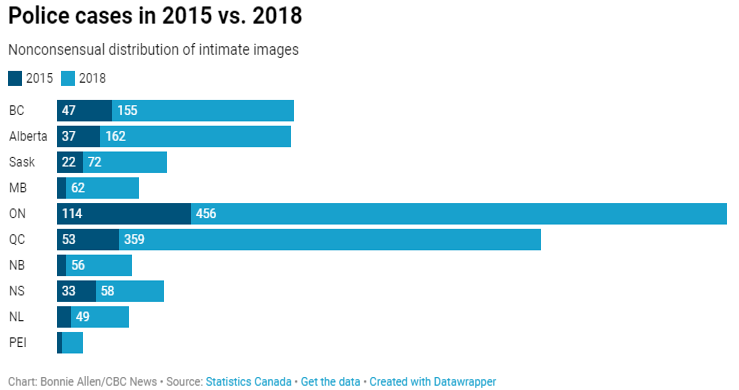In December 2014, the federal government criminalized the illegal circulation of intimate images and videos following the suicides of two teenagers – Rehtaeh Parsons and Amanda Todd. Both took their lives after being subjected to horrific episodes of cyber-bullying and harassment, including widespread distribution of nude pictures.
Amanda killed herself after posting a YouTube video claiming she was being blackmailed by an online predator; Rehtaeh hung herself after one of her alleged rapists took a picture of her during her gang rape and later subjected her to bullying. Sadly, even after cyber-bullying and non-consensual distribution of private images was criminalized by the Canadian government, statistics show that rates for these crimes remain high. According to CBC News, more than 1,500 cases of bullying were reported to police in 2017 and 2018, and the number since the law came into effect surpassed 5,000 in 2019. Every province saw an increase in cases between 2015 and 2018.

While the numbers are alarming and the threat is real, we should consider looking at the opposite perspective. Just as it’s crucial to have anti-bullying laws in place, it’s important to defend those falsely accused of such crimes. If you’re being falsely accused of cyber-bullying, you deserve a fair hearing. Before hiring a lawyer to defend you and help you decide what to do next, you should know the legal aspects of cyber-bullying.
Understanding the Legal Fundamentals of Cyber-Bullying
What Exactly is Cyber-Bullying?
When someone uses electronic communication – for example emails, text messages, phone calls and social media platforms – to harm or bully someone, it’s called ‘cyber-bullying’. The accused either intentionally harmed or attempted to harm someone’s health or social stature, or they did so carelessly without thinking about the destructive consequences.
Common instances of cyber-bullying include:
- revealing or circulating sensitive images, personal facts or confidential details about someone else.
- sending pornography or other offensive graphic material to the victim.
- threatening or intimidating another individual.
- harassing another person, including during live chats.
- making false accusations.
- sending viruses by e-mail (electronic sabotage).
- making defamatory comments about the victim on the Internet.
- communicating in an offensive, indecent or obscene manner.
- taking over the online identity of another person.
- encouraging or creating a circumstance for another person to commit suicide.
- demeaning or criticizing another person on the grounds of their skin colour, race, religion or sexual orientation.
- child pornography offences.
Anyone who encourages others to commit one or more of these crimes can also be accused of cyber-bullying.
Sharing of Intimate Images and Legal Penalties
What is an intimate image?
Many factors come together to define an ‘intimate image’:
- Any visual recording of a person, including photographs, films, videos or any other kind of visual recording
- The person depicted in the image had a reasonable expectation of privacy when the image was taken
- The person in the image is
- completely nude
- exposing their genitals or anal region
- exposing her breasts
- involved in explicit sexual activity
- When the image was shared, the person in the image didn’t expect it to be circulated or did so only among people of their choosing
What does ‘sharing an intimate image without consent’ mean?
To share an intimate image without consent means to make the content available to everyone under either of the following conditions:
- The person circulating the image knew that the person depicted in it wasn’t aware or didn’t consent to its distribution
- The person circulating the image was irresponsible and didn’t care to find out if the person depicted in the image had complied with its distribution
Sharing can be in any form, including online publishing, advertising, selling and transmitting.
Potential Legal Consequences
Under Section 162.1 of Canada’s Criminal Code, it’s illegal to share intimate images of a person without their consent. The law came into force March 10, 2015, and is applicable to everyone, including those under 18. The objective of this law is to protect the privacy of a person in his or her nudity or sexual life. Whether the crime was committed intentionally (this is often called ‘revenge porn’) or not, the impact of this type of cyber-bullying can be disastrous to a person’s reputation, self-respect and mental peace. In some cases, as discussed above, it instigated victims to take their own lives. Considering the seriousness of the crime, those convicted can face serious legal consequences.
- They could be sentenced to imprisonment for up to five years.
- Their cell phone, computer, laptop or other device used in the crime could be seized.
- The court could order them to reimburse the victim for expenses incurred in getting the image removed from the Internet or elsewhere.
Accused of Cyber-Bullying? What Are Your Options?
As with any criminal charge, your defence will depend on the circumstances and specific details of your case.
While cyber-bullying is a serious offence and deserves the highest level of penalty, there are instances where people are falsely or mistakenly accused of such crimes. If you or someone you know is being charged with cyber-harassment, the first step is to stop all communication with the accuser to avoid further complications. The second is to call a criminal attorney with a proven track record near you. Even if you’re under police investigation or have been served with a search warrant, it’s never too soon to consult a criminal lawyer to gather the required evidence and protect your rights.

